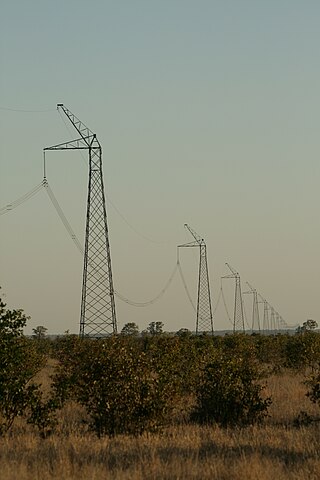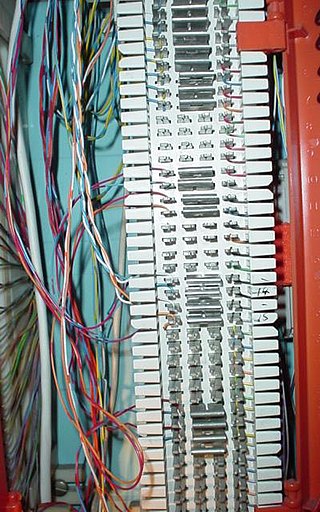
An electrical insulator is a material in which electric current does not flow freely. The atoms of the insulator have tightly bound electrons which cannot readily move. Other materials—semiconductors and conductors—conduct electric current more easily. The property that distinguishes an insulator is its resistivity; insulators have higher resistivity than semiconductors or conductors. The most common examples are non-metals.

In telephony, a main distribution frame is a signal distribution frame for connecting equipment to cables and subscriber carrier equipment.
On-premises wiring is customer-owned telecommunication transmission or distribution lines. The transmission lines may be metallic (copper) or optical fiber, and may be installed within or between buildings.

In telecommunication, the term outside plant has the following meanings:

Component video is an analog video signal that has been split into two or more component channels. In popular use, it refers to a type of component analog video (CAV) information that is transmitted or stored as three separate signals. Component video can be contrasted with composite video in which all the video information is combined into a single signal that is used in analog television. Like composite, component cables do not carry audio and are often paired with audio cables.

Single-wire earth return (SWER) or single-wire ground return is a single-wire transmission line which supplies single-phase electric power from an electrical grid to remote areas at lowest cost. The earth is used as the return path for the current, to avoid the need for a second wire to act as a return path.

In telecommunications, a distribution frame is a passive device which terminates cables, allowing arbitrary interconnections to be made.
Electrical wiring in the United Kingdom is commonly understood to be an electrical installation for operation by end users within domestic, commercial, industrial, and other buildings, and also in special installations and locations, such as marinas or caravan parks. It does not normally cover the transmission or distribution of electricity to them.

A utility pole is a column or post, usually made out of wood or aluminum alloy, used to support overhead power lines and various other public utilities, such as electrical cable, fiber optic cable, and related equipment such as transformers and street lights. It can be referred to as a transmission pole, telephone pole, telecommunication pole, power pole, hydro pole, telegraph pole, or telegraph post, depending on its application. A Stobie pole is a multi-purpose pole made of two steel joists held apart by a slab of concrete in the middle, generally found in South Australia.

In telecommunications, structured cabling is building or campus cabling infrastructure that consists of a number of standardized smaller elements called subsystems. Structured cabling components include twisted pair and optical cabling, patch panels and patch cables.

A 66 block is a type of punch-down block used to connect sets of wires in a telephone system. They have been manufactured in four common configurations, A, B, E and M. A and B styles have the clip rows on 0.25" centers while E and M have the clip rows on 0.20" centers. The A blocks have 25 slotted holes on the left side for position the incoming building cable with a 50 slot fanning strip on the right side for distribution cables. They have been obsolete for many years. The B & M styles have 50 slot fanning strip on both sides. The B style is used mainly in distribution panels where several destinations need to connect to the same source. The M blocks are often used to connect a single instrument to such a distribution block. The E style has 5 columns of 10 2 clips rows and are used for transitioning from the 25 pair distribution cable to a 25 pair RJ21 style female ribbon connector.

In petroleum and natural gas extraction, a Christmas tree, or tree, is an assembly of valves, casing spools, and fittings used to regulate the flow of pipes in an oil well, gas well, water injection well, water disposal well, gas injection well, condensate well, and other types of well.

A fly system, or theatrical rigging system, is a system of ropes, pulleys, counterweights and related devices within a theater that enables a stage crew to fly (hoist) quickly, quietly and safely components such as curtains, lights, scenery, stage effects and, sometimes, people. Systems are typically designed to fly components between clear view of the audience and out of view, into the large space, the fly loft, above the stage.

A Stockbridge damper is a tuned mass damper used to suppress wind-induced vibrations on slender structures such as overhead power lines, long cantilevered signs and cable-stayed bridges. The dumbbell-shaped device consists of two masses at the ends of a short length of cable or flexible rod, which is clamped at its middle to the main cable. The damper is designed to dissipate the energy of oscillations in the main cable to an acceptable level.

A tamping machine or ballast tamper, informally simply a tamper, is a self-propelled, rail-mounted machine used to pack the track ballast under railway tracks to make the tracks and roadbed more durable and level. Prior to the introduction of mechanical tampers, this task was done by manual labour with the help of beaters. As well as being faster, more accurate, more efficient and less labour-intensive, tamping machines are essential for the use of concrete sleepers since they are too heavy to be lifted by hand.

The 1A2 Key Telephone System is a business telephone system developed and distributed by the Western Electric Company for the Bell System.
The Number Five Crossbar Switching System is a telephone switch for telephone exchanges designed by Bell Labs and manufactured by Western Electric starting in 1947. It was used in the Bell System principally as a Class 5 telephone switch in the public switched telephone network (PSTN) until the early 1990s, when it was replaced with electronic switching systems. Variants were used as combined Class 4 and Class 5 systems in rural areas, and as a TWX switch.
This glossary defines terms that are used in the document "Defining Video Quality Requirements: A Guide for Public Safety", developed by the Video Quality in Public Safety (VQIPS) Working Group. It contains terminology and explanations of concepts relevant to the video industry. The purpose of the glossary is to inform the reader of commonly used vocabulary terms in the video domain. This glossary was compiled from various industry sources.
On February 27, 1975, fire broke out at the New York Telephone Company switching center at 204 Second Avenue and Thirteenth Street in the East Village of Manhattan, New York City. At this time, the building contained central offices for connecting local customer telephone lines, as well as toll switching systems. The fire disrupted service for 175,000 customers, connected within the building through 105,000 service loops. It was the worst single service disaster suffered by any single Bell operating company in the 20th century.
In radio systems, many different antenna types are used whose properties are especially crafted for particular applications.













